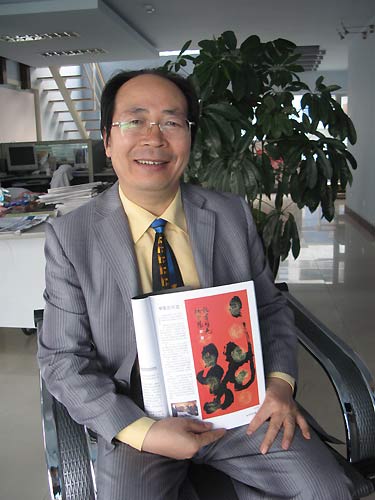Bureaus Exclusive
Hardworking calligrapher in artistic success, charity fame
By Ye Jun (China Daily Yunnan Bureau)
Updated: 2010-07-09 13:36
 |
Large Medium Small |
Lin Zhongyang was in primary school when his parents told him: "You need to study well, so that you can get out of here."
Born into a farmer's family in Gansu's Minqin county in 1957, poverty was what Lin remembered about most of his hometown. The family was so poor that he had no paper to practice calligraphy, which he liked best as a primary school student. He had to practice on sand in the desert.
 |
|
Chinese calligrapher Lin Zhongyang in file photo. [Provided for China Daily] |
In Lin's time, beautiful handwriting by traditional brush pen was considered a great expertise, and a sign of a proficient scholar. He practiced so hard, that by the time he got to junior school and high school, he was considered one of the students that wrote the best Chinese characters.
Chinese calligraphy is an art only in China. Thirty years later, as a self-taught Chinese professional calligrapher, Lin Zhongyang has not only been successful in his career, but also in contributing to charity.
Now 53, Lin is the executive director of China Calligraphy Art Institute. On April 12, the now Beijing-based calligrapher donated three calligraphy works for auction in Kunming to help fight drought in Yunnan. His calligraphy works are evaluated at a market price of 3,500-4,500 yuan per square foot.
"I'm the son of a farmer, and now that I'm financially capable, it's time I repay society," he said.
He's been donating to Project Hope since 2002, according to the Beijing-based calligrapher. He has donated 100,000 yuan each to 11 Hope Primary Schools, and financed two university scholarships.
In 1977, China restored the college entrance exam, and Lin went to college to study Chinese medicine. He studied ancient medical literature, which he later found useful to his calligraphy practice. Afterwards, he was able to further his calligraphy studies in the Chinese College of Advanced Calligraphy.
Like any other diligent Chinese calligrapher, Lin started by copying ancient Chinese calligrapher's works. He began with Tang Dynasty's Kaishu, a regular handwriting, proceeded to Dazhuan, big seal character, and Lishu, Han Dynasty's official script, and then, Caoshu, grass hand.
"For Kaishu, I imitated the writing of Yan Zhenqing and Liu Gongquan, known for their distinct writing styles: Yan style, and Liu style," he says. "For Dazhuan I studied scripts engraved on an ancient vessel Maogong Ding, and on an ancient stone plate Sanshipan."
When he studied Lishu he copied Zhang Qian's style, and Shimen Eulogy. Finally he imitated Caoshu, grass hands, of Wang Xizhi and Wang Xianzhi, namely, the "Two Wangs", famous calligraphers of Eastern Jin Dynasty (317—420AD).
Each major writing style has unique characteristics, according to Lin. Kaishu is an elegant, regular style with relatively strict rules. Caoshu, grass hand, is designed to write fast, and pass over many strokes, although there are still rules to follow. Xingshu, running hand, is a style between Kaishu and Xingshu.
For several thousand years' time the Chinese used brush pen to write. Calligraphy by brush pen evolved from a tool of spreading culture to a form of art.
"First of all, Chinese characters have a unique square shape, with special symbolic structures," says Lin. "Secondly, writing by brush pen has a profuse expressive force for the calligrapher to endow different emotions."
Lin explained that the lift and fall of a brush pen can be done with different strength. The color of ink can be dense or light. The upper side and the downside, or the left and right sides of a Chinese character links up to, or corresponds with each other.
"Calligraphers express their emotions by writing the lines and strokes of Chinese characters differently," says Lin. "Chinese words, such as those for mountain and water, are pictographic characters expressing Chinese ancestors' understanding of nature. Therefore calligraphy is an important way to pass on Chinese culture, as well as to cultivate oneself."
"Chinese calligraphy is an abstract art to express concepts through strokes," Lin explains. "Aesthetics and philosophy are important in dealing with the relationship between different parts of a character. Meanwhile, each word has its cultural background."
To Lin, Chinese handwriting needs to have the rhythm of music, and the swing of dance. To produce good calligraphy, one needs to be consistent in writing, and the qi of the characters must be complete and without interruption. The finish of one character is linked with the start of the next, invisibly. The work should be finished without stopping in between.
"The best writing is when the words become alive," he says. "The words will have their soul and be able to tell people their stories."
The popularization of computers may have made many things convenient for people, but it has brought some unexpected side effects. Many young people nowadays find they forget how to write some Chinese characters when they need to.
Lin Zhongyang believes it is a dangerous signal.
"A lack of proficiency in Chinese handwriting is a sign that cultural tradition is being neglected," he said. "The world is studying Chinese, and Confucianism. As a part of traditional Chinese culture, calligraphy by brush pen needs to be carried forward. This has to start from young people."